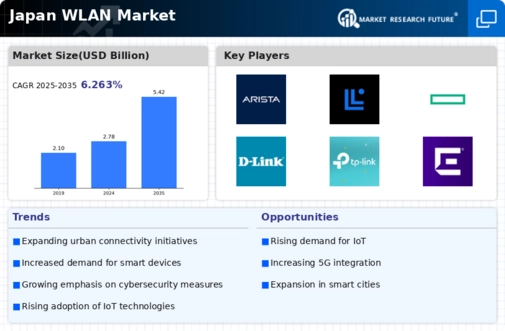Growth of Smart Devices
The proliferation of smart devices in Japan significantly impacts the wlan market. With an estimated 90 million smart devices in use, including smartphones, tablets, and IoT devices, the demand for reliable wireless connectivity is at an all-time high. This surge in device adoption necessitates the expansion of wlan networks to accommodate the increasing number of connected devices. Moreover, the integration of smart home technologies is driving consumers to seek advanced wireless solutions that can support multiple devices simultaneously. As a result, the wlan market is likely to experience substantial growth as manufacturers and service providers adapt to these evolving consumer needs.
Emergence of 5G Technology
The rollout of 5G technology in Japan is poised to revolutionize the wlan market. With its promise of ultra-fast speeds and low latency, 5G is expected to complement existing wireless networks and enhance overall connectivity. As businesses and consumers alike begin to adopt 5G-enabled devices, the demand for seamless integration with wlan networks will likely increase. This transition presents opportunities for innovation within the wlan market, as companies explore new applications and services that leverage the capabilities of 5G. The convergence of 5G and wlan technologies may lead to enhanced user experiences and drive further investment in wireless infrastructure.
Increased Mobile Data Consumption
The surge in mobile data consumption in Japan is a significant driver for the wlan market. With mobile data usage projected to grow by over 30% in the coming years, the demand for efficient wireless networks is becoming increasingly critical. Consumers are utilizing mobile devices for various applications, including video streaming, online gaming, and remote work, which places additional strain on existing wlan infrastructure. To address this challenge, service providers are investing in advanced technologies such as Wi-Fi 6, which offers improved speed and capacity. This shift not only enhances user experience but also positions the wlan market for sustained growth as it adapts to changing consumer behaviors.
Rising Demand for High-Speed Internet
The increasing demand for high-speed internet access in Japan is a primary driver for the wlan market. As more consumers and businesses seek faster connectivity, the need for advanced wireless solutions becomes evident. Reports indicate that approximately 80% of households in urban areas are now equipped with high-speed internet, which propels the wlan market forward. This trend is further fueled by the growing reliance on cloud-based services and streaming platforms, which require robust wireless networks. Consequently, service providers are investing heavily in upgrading their infrastructure to meet these demands, thereby enhancing the overall wlan market landscape.
Government Initiatives for Digital Transformation
The Japanese government is actively promoting digital transformation initiatives, which serve as a catalyst for the wlan market. Programs aimed at enhancing digital infrastructure and connectivity are being implemented across various sectors, including education, healthcare, and transportation. For instance, the government has allocated approximately $1 billion to improve wireless infrastructure in rural areas, ensuring equitable access to high-speed internet. Such initiatives not only bolster the wlan market but also encourage private sector investment in wireless technologies. This collaborative effort between the government and industry stakeholders is expected to drive innovation and expand the wlan market in Japan.






















Leave a Comment